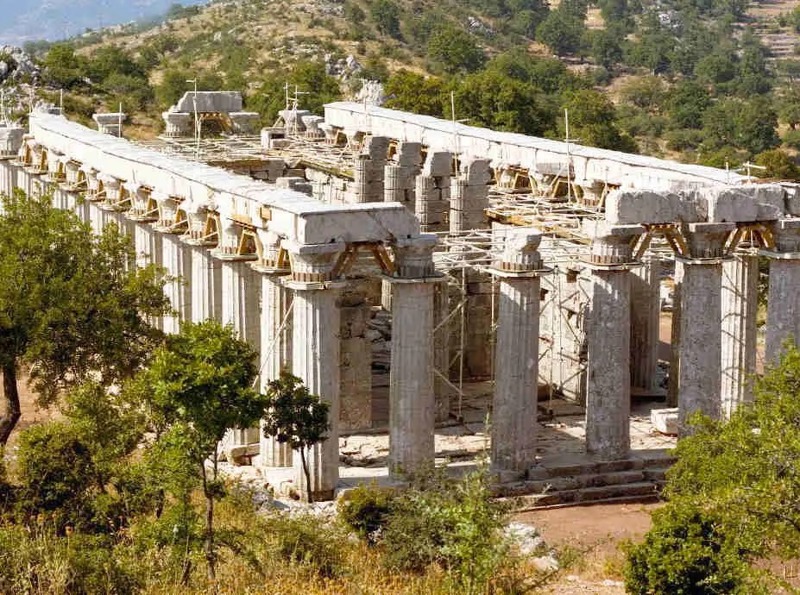Travel Log
Nestled amidst the rugged terrain of the Arcadian mountains in the Peloponnese, the Temple of Apollo Epikourios at Bassae stands as a testament to ancient Greece's architectural ingenuity and cultural significance. Constructed in the mid-5th century BCE, this Doric masterpiece is renowned for its remote location, exquisite craftsmanship, and unique architectural features.
As I approached the temple tucked away in a secluded valley, I was struck by its pristine state of preservation. Unlike many ancient Greek temples, which have succumbed to the ravages of time and human intervention, the Temple of Apollo Epikourios remains remarkably intact, thanks in part to its remote location and the efforts of modern conservationists.
The temple's architectural design is a marvel of engineering and artistic expression. Its elegant Doric columns, meticulously carved from local limestone, rise majestically against the backdrop of the surrounding mountains, creating a sense of harmony and balance with the natural landscape. The temple's interior features a unique layout, with a single row of columns running along the central axis, leading to the inner sanctum where the cult statue of Apollo once stood.
One of the most striking features of the Temple of Apollo Epikourios is its unusual orientation, with the main entrance facing south instead of the traditional east-west orientation of most Greek temples. This architectural quirk has puzzled historians and archaeologists for centuries, leading to speculation about its possible astronomical, religious, or symbolic significance.
The temple's dedication to Apollo Epikourios, the god of healing and protection, suggests that it may have served as a sanctuary for pilgrims seeking solace and divine intervention in times of sickness and hardship. Indeed, the remote location of Bassae, far from the bustling city-states of ancient Greece, may have offered a tranquil retreat for worshippers seeking respite from the chaos of everyday life.
Despite its remote location, the Temple of Apollo Epikourios played a significant role in ancient Greece's religious and cultural life. Pilgrims from across the Greek world would have made the arduous journey to Bassae to
Joe Lee
5 chapters
28 Feb 2024
The Temple of Apollo Epikourios at Bassae
February 25, 2024
Nestled amidst the rugged terrain of the Arcadian mountains in the Peloponnese, the Temple of Apollo Epikourios at Bassae stands as a testament to ancient Greece's architectural ingenuity and cultural significance. Constructed in the mid-5th century BCE, this Doric masterpiece is renowned for its remote location, exquisite craftsmanship, and unique architectural features.
As I approached the temple tucked away in a secluded valley, I was struck by its pristine state of preservation. Unlike many ancient Greek temples, which have succumbed to the ravages of time and human intervention, the Temple of Apollo Epikourios remains remarkably intact, thanks in part to its remote location and the efforts of modern conservationists.
The temple's architectural design is a marvel of engineering and artistic expression. Its elegant Doric columns, meticulously carved from local limestone, rise majestically against the backdrop of the surrounding mountains, creating a sense of harmony and balance with the natural landscape. The temple's interior features a unique layout, with a single row of columns running along the central axis, leading to the inner sanctum where the cult statue of Apollo once stood.
One of the most striking features of the Temple of Apollo Epikourios is its unusual orientation, with the main entrance facing south instead of the traditional east-west orientation of most Greek temples. This architectural quirk has puzzled historians and archaeologists for centuries, leading to speculation about its possible astronomical, religious, or symbolic significance.
The temple's dedication to Apollo Epikourios, the god of healing and protection, suggests that it may have served as a sanctuary for pilgrims seeking solace and divine intervention in times of sickness and hardship. Indeed, the remote location of Bassae, far from the bustling city-states of ancient Greece, may have offered a tranquil retreat for worshippers seeking respite from the chaos of everyday life.
Despite its remote location, the Temple of Apollo Epikourios played a significant role in ancient Greece's religious and cultural life. Pilgrims from across the Greek world would have made the arduous journey to Bassae to

pay homage to Apollo and seek his blessings. The temple's legacy serves as a reminder of the enduring power of faith and the timeless beauty of Greek architecture.
Standing before the Temple of Apollo Epikourios, surrounded by the pristine wilderness of the Arcadian mountains, I couldn't help but feel a sense of awe and reverence for the ancient Greeks and their remarkable achievements. The temple's serene beauty and remote location offered a glimpse into ancient Greece's spiritual and cultural world, inviting visitors to contemplate the mysteries of the past and marvel at the enduring legacy of one of civilization's greatest civilizations.
Share your travel adventures like this!
Create your own travel blog in one step
Share with friends and family to follow your journey
Easy set up, no technical knowledge needed and unlimited storage!